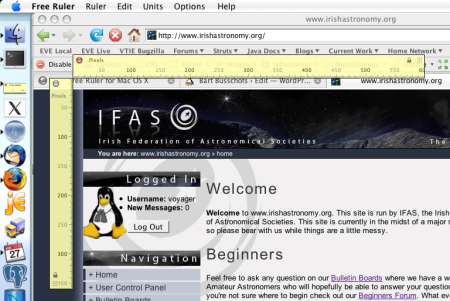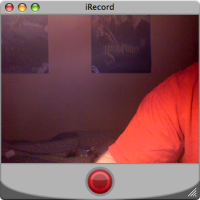Apr
20
Create PDFs for Free on Windows
Filed Under Computers & Tech on April 20, 2007 | 1 Comment
On the Mac you can turn anything you can print into a PDF for free right out of the box because the standard OS X Print Dialog has a button for making your print job into a PDF. Now you can get the same level of functionality for Windows for free with no strings attached (released under GPL) with PDF Creator. This works by providing a special printer driver that saves your print jobs as PDFs.
[tags]PDF[/tags]
Mar
25
PasswordVault2Go – A Great Shareware Tool
Filed Under Computers & Tech, Security on March 25, 2007 | Leave a Comment
Passwords are an annoying fact of life in our modern electronic world. If you’re any sort of regular computer user you’re going to start building up quite a collection. You could use the same user name and password for everything, but that’s very insecure. Also, you often don’t have a choice of user name, or you can run into very restrictive password policies, either way it’s unlikely you’ll manage to get the same user name and password everywhere even if you tried! Remembering the details for things you log in to every day is never the problem. It’s the passwords for the things you only use a few times a month or even a year that cause the problems. Saving passwords in browsers can help a bit but it makes things even worse when you try to use another computer and of course your browser isn’t going to be any help when it comes to remembering your domain password at work or your FTP password for that website you only update every few months. On top of all your passwords you also have software registration codes to keep track of and your browser certainly isn’t going to help you with that. Inevitably you end up getting locked out of sites or services and having to re-buy software you’ve bought before because you can’t find your registration key.
[tags]PasswordVault, PasswordVault2Go, Lava Software[/tags]
Mar
6
My Review of NetNewsWire 3 Preview Release on the NosillaCast
Filed Under Computers & Tech on March 6, 2007 | Leave a Comment
I did a review of the pre-beta preview release of NetNewsWire 3 for Allison on the NosillaCast. Check it out in Episode 85.
[tags]NosillaCast, NetNewsWire[/tags]
Feb
27
A Nice Free Tool for Measuring Pixel Sizes on Screen
Filed Under Computers & Tech on February 27, 2007 | 5 Comments
It’s often handy to figure out how big elements on your screen are in pixels. The freeware tool Free Ruler lets you do just that. This is another example of the kind of Mac programs I really like, those that do just one thing but do it very well. The program really couldn’t be simpler. You get a semi-transparent ruler that floats over the screen that you can move around. You actually get two rulers at 90o to each other and you can resize both independently though they move together. There’s not really much more to say about this tool so I’ll leave you with a screen shot.

[tags]OS X, Apple, Software, Free Ruler[/tags]
Feb
26
Two Tips for Getting More out of Thunderbird
Filed Under Computers & Tech on February 26, 2007 | 7 Comments
I’m probably a very rare beast, a Mac user who uses Thunderbird rather than Apple Mail. The reason I use Thunderbird is because I don’t like lock-in. I’ve had my same mailboxes on Windows, Linux and Mac, so I know that as long as I use Thunderbird I can move to any OS I want at any time and keep all my mail, contacts and settings completely effortlessly. I’d just have to copy one folder. It can certainly be argued that Thunderbird is less polished looking than Mac Mail and it has a few less features but on the whole it’s a very capable client that works well.
I’ve been using the basic features for years but of late the sheer volume of mail I have to deal with at work has led me to start experimenting with ways of making my life easier. The first optimization people generally think of is message filters so I’m not going to talk about those because I think they are pretty obvious and people are used to using them. Instead I’m going to give two hopefully less obvious tips.
[tags]Mozilla, Thunderbird, Email, To Do, Organise[/tags]
Feb
18
Two Free and Simple Video Tools for OS X
Filed Under Computers & Tech on February 18, 2007 | 2 Comments
One of the things I like best about the Mac platform is the abundance of good simple software tools that do one thing very well. Because of the frameworks Apple provide to Mac developers these tools all tend to share a common look and and feel and generally have very simple and intuative user interfaces (UIs). Personally I really like this approach to software, give me lots of small and simple apps that do one thing really well over a monolith that does millions of things poorly any day!
 iRecord is the perfect example of this kind of Mac tool. The one thing it does is quickly and simply record video from your iSight camera. The (UI) could not be simpler, it has a grand total of one button! It’s a big red record button, you push it to start recording and again to stop. That’s all you have to do. Your video gets saved to your desktop.
iRecord is the perfect example of this kind of Mac tool. The one thing it does is quickly and simply record video from your iSight camera. The (UI) could not be simpler, it has a grand total of one button! It’s a big red record button, you push it to start recording and again to stop. That’s all you have to do. Your video gets saved to your desktop.
 The second tool I want to talk about is Perian, the ‘Swizz-Army Knife for Quicktime’. Perian is a Quicktime component that adds support for extra codecs to Quicktime. I came across this tools while looking for a free FLV (Flash Video) player for OS X. It deals with FLVs wonderfully as well as AVIs and DivXs. You can see a full list of the codecs supported on the web-page. For Mac users who are used to drag-and-drop installs installing a Quicktime component may seem a bit tricky since you actually have to copy it to the Quicktime folder in the Library folder on your hard-drive. However, a cleverly designed DMG file makes installing Perian trivial, drag a few pixels, drop, done!
The second tool I want to talk about is Perian, the ‘Swizz-Army Knife for Quicktime’. Perian is a Quicktime component that adds support for extra codecs to Quicktime. I came across this tools while looking for a free FLV (Flash Video) player for OS X. It deals with FLVs wonderfully as well as AVIs and DivXs. You can see a full list of the codecs supported on the web-page. For Mac users who are used to drag-and-drop installs installing a Quicktime component may seem a bit tricky since you actually have to copy it to the Quicktime folder in the Library folder on your hard-drive. However, a cleverly designed DMG file makes installing Perian trivial, drag a few pixels, drop, done!
Both these tools are free and embody what I believe are the best things about Mac software. Enjoy!
Feb
9
TCPDump for Windows
Filed Under Computers & Tech, System Administration on February 9, 2007 | 3 Comments
It’s no secret that I’m not a Windows fan. There are many reasons I don’t like windows including idealogical disagreements with MicroSoft, a lack of faith and trust in MS, security concerns, usability issues etc.. I could go on but for this post only one reason matters, I feel very vulnerable on a Windows machine because I can’t see what it’s doing as easily as I can on Linux, Unix or OS X. There are many Linux command-line tools missing from Windows but now there is one fewer missing from my Windows machine in work. TCPDump is a Linux/Unix command for analyzing all the network traffic that is going to or from your machine. Errand network traffic is a good indicator that you have some form of spyware and being able to monitor traffic can be very useful for debugging network problems. There is a Windows port of TCPDump called WinDump. It’s not entirely straight forward so I’ll just go through how to install it and how to make it work. This will not be a tutorial on how to use TCPDump, for that go here. This is very much a tool for power-users, not regular Windows users.
[tags]Windows, Security, WinDump, TCPDump[/tags]
Jan
8
Musings on What iLife 07 May Bring
Filed Under Computers & Tech on January 8, 2007 | 2 Comments
A pretty major omission from my MacWorld 2007 predictions is iLife 07. No idea why my brain wasn’t tuned in to the fact that every MacWorld I remember seems to have brought an iLife release, so why would the year be any different? You could argue that with Leopard on the way iLife may come later in the year, and that was my view for a while, but I’ve changed my mind. Anyhow, regardless of when it does come out I want to discuss what I’d like to see in it.
I don’t really use iMovie or iDVD enough to have anything interesting to say about them. I used both twice in iLife 06 and each time it was a problem-free and rewarding experience. I have a lot more experience with the other iLife components so I’m going to concentrate on those, namely iTunes, iPhoto, iWeb & GarageBand.
[tags]MacWorld, Apple, iLife, iTunes, iPhoto, iWeb, GarageBand[/tags]
Dec
21
Some Silliness for the Silly-Season
Filed Under Computers & Tech on December 21, 2006 | 2 Comments
If you’re the serious kind who wouldn’t dream of wasting their precious CPU cycles on pointless fluff or if you can’t stand kitsch then you should probably just stop reading now, this won’t be of any interest to you what so ever. If you on the other hand, you have an over-abundance of festive spirit and some spare CPU cyles (and you run OS X) then MacLampX is just the thing for you.
Nov
28
The Easy Way to Completely Remove an App on OS X
Filed Under System Administration, Computers & Tech on November 28, 2006 | 4 Comments
There are two ways of dealing with the configuration details that applications need to store. You have the Windows model, throw the lot into the Registry, and the Linux/Unix model, use text files in people’s home directories. There are advantages and disadvantages to both, but on balance, I prefer the Linux/Unix model. Apple have taken the Linux/Unix approach but rather than storing the configuration files in straight in your home directory OS X stores them in the Library folder within your home directory. Although 99% of an application is gone when you drag it to the trash can, the configuration files in your Library are left behind. These take up very little room and don’t really get in your way but you might still like to get rid of them. If you’re the kind of person who is constantly installing and removing applications to test and play them you probably should look into tools for completely removing applications.
On the Mac there are two tools for this that I am aware of, AppZapper and AppDelete. It was Allison Sheridan of the NosillaCast that put me on to AppDelete. Like Allison I’ve played with both and agree that AppDelete is the better App of the two. It’s UI is the hight of simplicity, but perhaps so simple it may confuse people (more on this later). It also allows you to see what will be deleted and to un-do the deletion so there should be no nasty surprises! This is the perfect example of a tool that solves one problem very well. Basically, it does exactly what it says on the tin!






